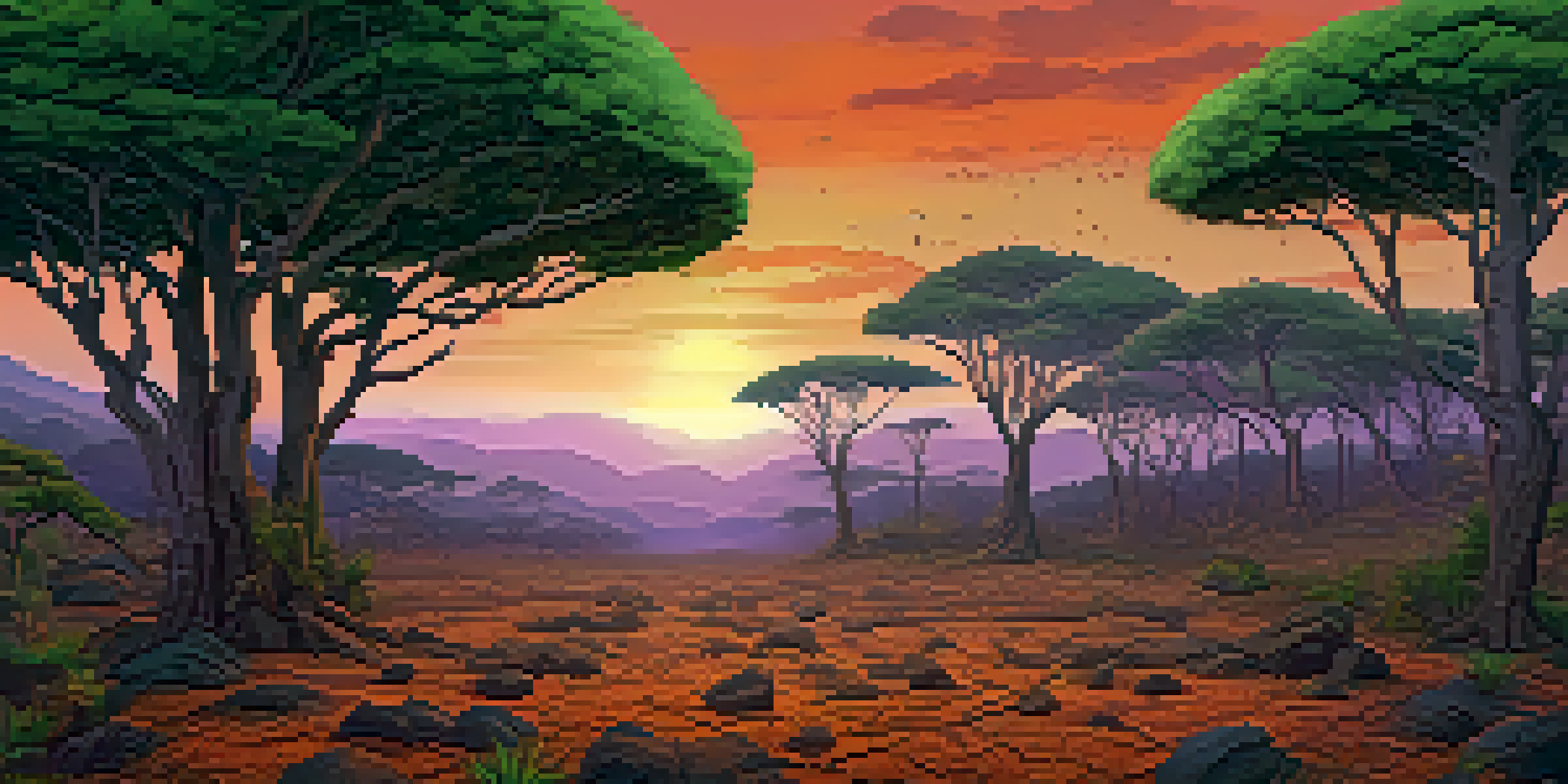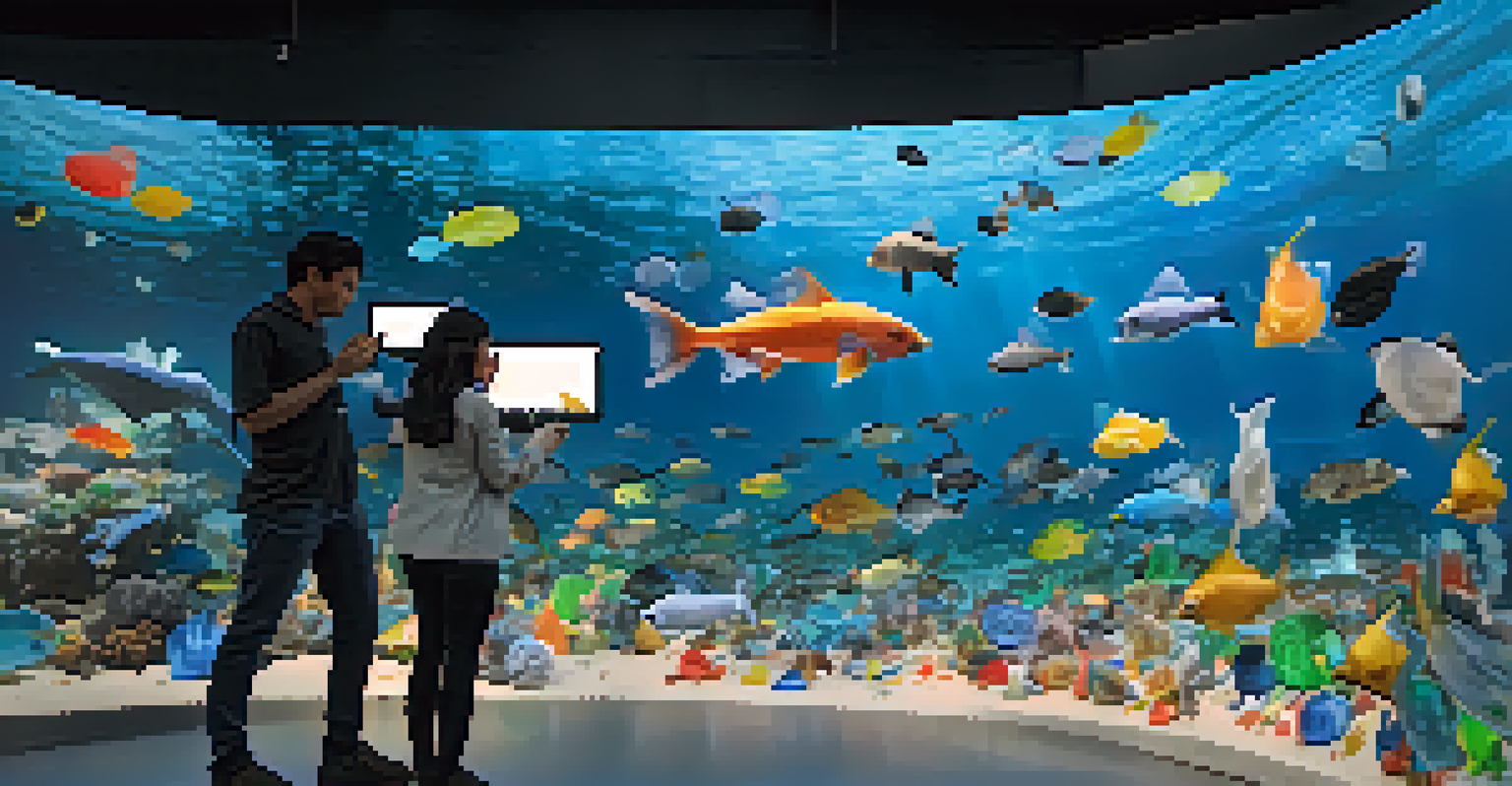The Role of Digital Art in Raising Environmental Awareness

Digital Art as a Tool for Environmental Storytelling
Digital art offers a unique platform for storytelling, allowing artists to convey powerful messages about environmental issues. Through vibrant visuals and engaging narratives, artists can illustrate the impact of climate change or pollution in ways that resonate with audiences. This storytelling aspect can evoke emotional responses, prompting viewers to reflect on their own environmental footprints.
Art is not a mirror to hold up to society, but a hammer with which to shape it.
For example, a digital artist might create a series depicting the transformation of a forest into a barren landscape due to deforestation. Such visuals can be more impactful than statistics alone, making the urgency of the situation more tangible to the viewer. By connecting art with real-world issues, digital art can serve as a catalyst for social change.
Moreover, digital art can be easily shared across social media platforms, amplifying its reach and influence. This accessibility means that artists can engage global audiences in conversations about sustainability, creating a collective movement toward environmental stewardship.
Engaging Communities Through Interactive Digital Installations
Interactive digital art installations invite viewers to engage directly with environmental themes, fostering a deeper connection to the issues presented. Imagine walking through an immersive exhibit where you can see the effects of plastic waste on marine life, while also learning how to reduce your own plastic usage. Such experiences can leave a lasting impression on participants.

These installations often utilize augmented reality (AR) or virtual reality (VR) technologies to create compelling experiences. For instance, AR can superimpose images of wildlife onto urban settings, highlighting how human activities impact these creatures. This blend of technology and art provides a fresh perspective, making environmental issues feel more immediate and personal.
Art Drives Environmental Awareness
Digital art effectively communicates environmental issues, prompting emotional responses and encouraging viewers to reflect on their impact.
By engaging communities in this manner, digital art can inspire action and advocacy, encouraging people to become more involved in environmental causes. When individuals feel connected to a cause, they are more likely to take steps to protect the environment.
Highlighting Environmental Issues Through Visual Campaigns
Visual campaigns featuring digital art can effectively raise awareness about pressing environmental issues. Artists often collaborate with organizations to create eye-catching graphics that communicate the urgency of climate change, pollution, and habitat destruction. These visuals serve as powerful reminders of the challenges our planet faces.
The greatest threat to our planet is the belief that someone else will save it.
For example, a campaign might use striking imagery of endangered species alongside statistics about their decline, prompting viewers to take action. The combination of art and data not only captures attention but also informs audiences about the significance of their actions. This dual approach can be more persuasive than traditional advertising methods.
Furthermore, successful visual campaigns can go viral, reaching a broader audience and generating discussions that extend beyond the art itself. This ripple effect can lead to increased public engagement and support for environmental initiatives, showcasing the potential of digital art in advocacy.
Promoting Sustainable Practices Through Digital Art
Digital art can also play a role in promoting sustainable practices and lifestyles. Artists often use their platforms to showcase eco-friendly alternatives, encouraging viewers to adopt greener habits. This could range from artwork that highlights the beauty of renewable energy sources to illustrations advocating for reduced waste.
For instance, an artist might create a series of infographics explaining the benefits of composting and recycling in a visually appealing format. By making sustainability appealing and accessible, digital art can motivate individuals to change their behaviors for the better. The creative presentation of these ideas can resonate with a diverse audience.
Interactive Installations Engage Audiences
Interactive digital art installations foster deeper connections to environmental themes, inspiring participants to take action.
Additionally, by collaborating with eco-conscious brands, artists can further amplify their messages. This partnership can result in campaigns that not only educate but also inspire action, showing that art and sustainability can go hand in hand.
The Role of Social Media in Spreading Digital Art
Social media has become an essential tool for sharing digital art, amplifying its reach, and engaging audiences in environmental discussions. Platforms like Instagram, TikTok, and Twitter allow artists to showcase their work while connecting with like-minded individuals. This instant sharing capability can lead to a snowball effect, where one piece of art sparks conversations and inspires others to create.
For example, hashtags related to environmental art can help users discover new artists and campaigns focused on sustainability. This not only fosters community but also highlights the importance of collective action against environmental degradation. The viral nature of social media can turn a single artwork into a global movement.
Moreover, artists often use these platforms to engage directly with their audience, inviting feedback and collaboration. This interactive approach can deepen the impact of their work, as viewers feel personally invested in the issues being addressed. In this way, social media serves as a powerful ally for digital artists advocating for the environment.
Collaborations Between Artists and Environmental Organizations
Collaborations between digital artists and environmental organizations can lead to impactful projects that raise awareness and inspire action. These partnerships harness the creative vision of artists alongside the expertise of environmental advocates, creating a powerful synergy. Together, they can develop campaigns that resonate with audiences and drive real change.
For instance, an artist might work with a conservation group to create a series of stunning visuals that depict the beauty of endangered ecosystems. These images can be used in educational materials, social media campaigns, and fundraising efforts, amplifying the message and creating a cohesive narrative around the importance of conservation.
Social Media Amplifies Artistic Impact
Social media serves as a powerful platform for sharing digital art, generating discussions, and mobilizing collective action for environmental causes.
Such collaborations not only elevate the visibility of environmental issues but also provide artists with opportunities to make a meaningful contribution to the cause. By combining their talents, both artists and organizations can inspire a broader audience to engage with sustainability efforts.
The Future of Digital Art in Environmental Advocacy
As technology continues to evolve, the potential for digital art in environmental advocacy is limitless. Emerging technologies like artificial intelligence and blockchain could introduce new ways for artists to engage with audiences and promote sustainability. For example, AI-generated art can raise awareness about environmental issues by creating visuals that reflect data trends.
Furthermore, as digital art becomes more mainstream, we are likely to see an increase in projects that focus on environmental themes. Artists may explore innovative formats, such as interactive web experiences or immersive installations, to captivate audiences and spark conversations about the planet's future. This evolution can keep the dialogue fresh and engaging.

Ultimately, the fusion of art and technology positions digital art as a vital player in the fight for environmental awareness. By leveraging creative expression, artists can inspire change and encourage individuals to take action in protecting the environment, ensuring that future generations inherit a healthier planet.